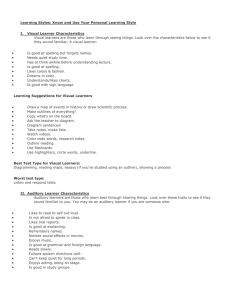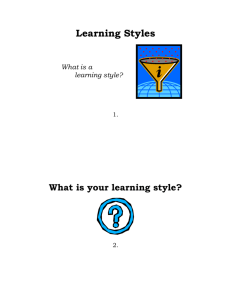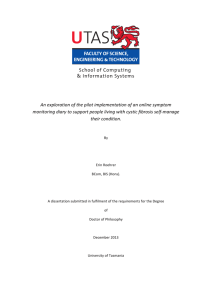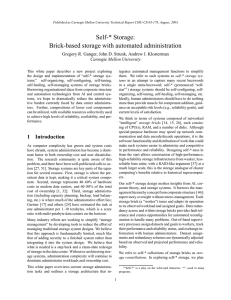Learning Styles: A Lesson Plan
advertisement
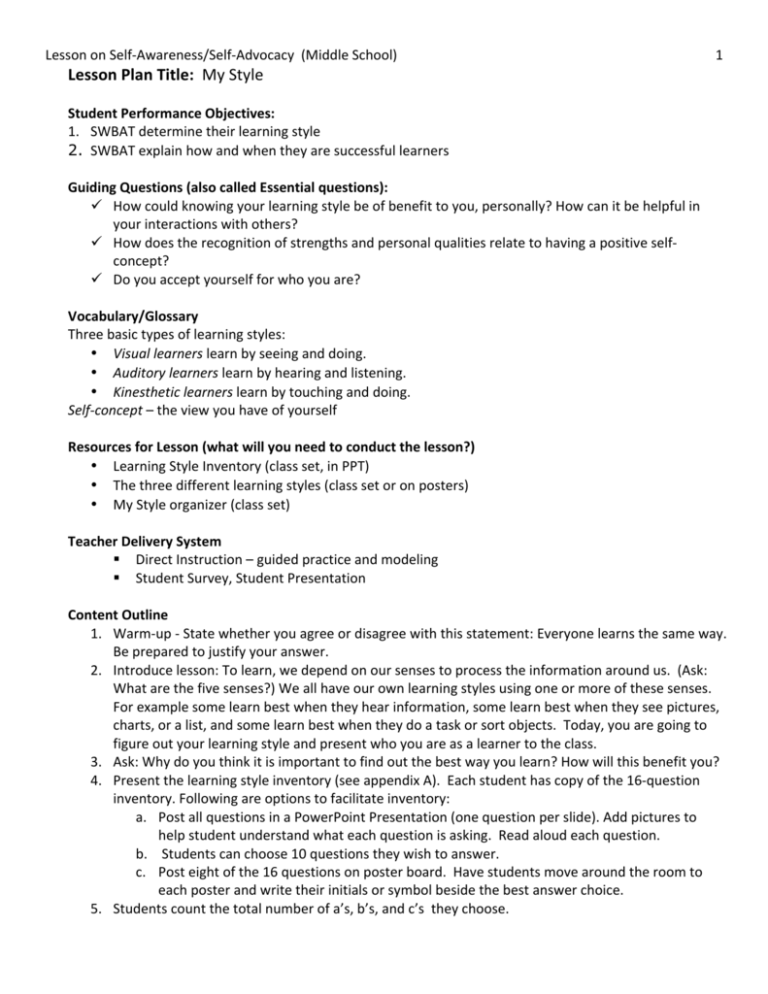
Lesson on Self-­‐Awareness/Self-­‐Advocacy (Middle School) Lesson Plan Title: My Style 1 Student Performance Objectives: 1. SWBAT determine their learning style 2. SWBAT explain how and when they are successful learners Guiding Questions (also called Essential questions): How could knowing your learning style be of benefit to you, personally? How can it be helpful in your interactions with others? How does the recognition of strengths and personal qualities relate to having a positive self-­‐ concept? Do you accept yourself for who you are? Vocabulary/Glossary Three basic types of learning styles: • Visual learners learn by seeing and doing. • Auditory learners learn by hearing and listening. • Kinesthetic learners learn by touching and doing. Self-­‐concept – the view you have of yourself Resources for Lesson (what will you need to conduct the lesson?) • Learning Style Inventory (class set, in PPT) • The three different learning styles (class set or on posters) • My Style organizer (class set) Teacher Delivery System Direct Instruction – guided practice and modeling Student Survey, Student Presentation Content Outline 1. Warm-­‐up -­‐ State whether you agree or disagree with this statement: Everyone learns the same way. Be prepared to justify your answer. 2. Introduce lesson: To learn, we depend on our senses to process the information around us. (Ask: What are the five senses?) We all have our own learning styles using one or more of these senses. For example some learn best when they hear information, some learn best when they see pictures, charts, or a list, and some learn best when they do a task or sort objects. Today, you are going to figure out your learning style and present who you are as a learner to the class. 3. Ask: Why do you think it is important to find out the best way you learn? How will this benefit you? 4. Present the learning style inventory (see appendix A). Each student has copy of the 16-­‐question inventory. Following are options to facilitate inventory: a. Post all questions in a PowerPoint Presentation (one question per slide). Add pictures to help student understand what each question is asking. Read aloud each question. b. Students can choose 10 questions they wish to answer. c. Post eight of the 16 questions on poster board. Have students move around the room to each poster and write their initials or symbol beside the best answer choice. 5. Students count the total number of a’s, b’s, and c’s they choose. Lesson on Self-­‐Awareness/Self-­‐Advocacy (Middle School) 2 6. Explain each learning style and what they style means to being a student (see appendix B). Options for presentation: a. Post characteristic of each learning style in PPT. b. Create poster of each learning style characteristics. c. Present videos of each learning style. d. Provide examples of each learning style. For example, for a visual learner, a teacher can say: Four quarters is equal to one dollar. Teacher posts visual of four quarters equal to one dollar. Teacher places four quarters and one dollar on student’s desk and asks them to count four quarters and place them on the dollar. 7. Students discuss their learning styles. If a student has mostly a’s they are a visual learner; mostly b’s auditory learner; and mostly c’s kinesthetic learner. Ask students if they agree with their results. 8. Ask students to provide examples of when they are successful in the classroom and explain how this relates to their learning style. 9. Students complete the My Style organizer (see appendix C). Explain to students that they will present their style to the classroom. Other options: a. Students can create flash cards using the prompts from the My Style sheet b. Students can create a poster using the prompts from the My Style sheet c. Students can create a PowerPoint presentation, if computer available. 10. Student presentations of My Style. 11. Closure Assessment (list the assessment and match it to each objective of the lesson) Objective 1 – Inventory (process and completion) Objective 2 – My Style presentation (create rubric for written and oral components) Technology Power Point Presentation Closure Whole group summary. Ask critical questions. o Based on what you learned about each other’s learning styles, what are some activities we can do in the classroom to meet everyone’s styles? o Why is it important to be able to explain to someone how you learn? o Why is it important to know who we are as a learner? How does knowing who we are affect our behavior and our relationship with others? Key points to drive home: o Students need to understand how they learn and what their strengths are as learners to be able to adopt and advocate for strategies that will help them be successful. o By being aware of themselves as learners, student can begin to determine what they need from teachers and other adults and advocate for accommodations to meet learning needs. o Everyone is able to learn. Even when you feel that something is hard and confusing, know that you are able to figure it out using the strategies that work for you. Remember, there is always another way. o You matter. The more you are able to understand your strengths and what you are good at, the better you are able to make an positive impact in your own life and the life of others. Lesson on Self-­‐Awareness/Self-­‐Advocacy (Middle School) Appendix A What's Your Learning Style? For these questions, choose the first answer that comes to mind. Don't spend too much time thinking about any one question. Question 1 When you study for a test, would you rather a) read notes, read headings in a book, and look at diagrams and illustrations. b) have someone ask you questions, or repeat facts silently to yourself. c) write things out on index cards and make models or diagrams. Question 2 Which of these do you do when you listen to music? a) daydream (see things that go with the music) b) hum along c) move with the music, tap your foot, etc. Question 3 When you work at solving a problem do you a) make a list, organize the steps, and check them off as they are done b) make a few phone calls and talk to friends or experts c) make a model of the problem or walk through all the steps in your mind Question 4 When you read for fun, do you prefer a) a travel book with a lot of pictures in it b) a mystery book with a lot of conversation in it c) a book where you answer questions and solve problems Question 5 To learn how a computer works, would you rather a) watch a movie about it b) listen to someone explain it c) take the computer apart and try to figure it out for yourself 3 Lesson on Self-­‐Awareness/Self-­‐Advocacy (Middle School) Question 6 You have just entered a science museum, what will you do first? a) look around and find a map showing the locations of the various exhibits b) talk to a museum guide and ask about exhibits c) go into the first exhibit that looks interesting, and read directions later Question 7 What kind of restaurant would you rather not go to? a) one with the lights too bright b) one with the music too loud c) one with uncomfortable chairs Question 8 Would you rather go to a) an art class b) a music class c) an exercise class Question 9 Which are you most likely to do when you are happy? a) grin b) shout with joy c) jump for joy Question 10 If you were at a party, what would you be most likely to remember the next day? a) the faces of the people there, but not the names b) the names but not the faces c) the things you did and said while you were there Question 11 When you see the word "d -­‐ o -­‐ g", what do you do first? a) think of a picture of a particular dog b) say the word "dog" to yourself silently c) sense the feeling of being with a dog (petting it, running with it, etc.) 4 Lesson on Self-­‐Awareness/Self-­‐Advocacy (Middle School) Question 12 When you tell a story, would you rather a) write it b) tell it out loud c) act it out Question 13 What is most distracting for you when you are trying to concentrate? a) visual distractions b) noises c) other sensations like, hunger, tight shoes, or worry Question 14 What are you most likely to do when you are angry? a) scowl b) shout or "blow up" c) stomp off and slam doors Question 15 When you aren't sure how to spell a word, which of these are you most likely to do? a) write it out to see if it looks right b) sound it out c) write it out to see if it feels right Question 16 Which are you most likely to do when standing in a long line at the movies? a) look at posters advertising other movies b) talk to the person next to you c) tap your foot or move around in some other way Source: http://people.usd.edu/~bwjames/tut/learning-­‐style/stylest.html 5 Lesson on Self-­‐Awareness/Self-­‐Advocacy (Middle School) Appendix B 6 Three Different Learning Styles Mostly a's: you may have a visual learning style. You learn by seeing and looking. Visual Learners • take numerous detailed notes • tend to sit in the front • are usually neat and clean • often close their eyes to visualize or remember something • find something to watch if they are bored • like to see what they are learning • benefit from illustrations and presentations that use color • are attracted to written or spoken language rich in imagery • prefer stimuli to be isolated from auditory and kinesthetic distraction • find passive surroundings ideal Mostly b's: you may have an auditory learning style. You learn by hearing and listening. Auditory Learners • sit where they can hear but needn't pay attention to what is happening in front • may not coordinate colors or clothes, but can explain why they are wearing what they are wearing and why • hum or talk to themselves or others when bored • acquire knowledge by reading aloud • remember by verbalizing lessons to themselves (if they don't they have difficulty reading maps or diagrams or handling conceptual assignments like mathematics). Mostly c's: you may have a kinesthetic learning style. You learn by touching and doing. Kinesthetic Learners • need to be active and take frequent breaks • speak with their hands and with gestures • remember what was done, but have difficulty recalling what was said or seen • find reasons to tinker or move when bored • rely on what they can directly experience or perform • activities like cooking, construction, engineering and art help them perceive and learn • enjoy field trips and tasks that involve manipulating materials • sit near the door or someplace else where they can easily get up and move around • are uncomfortable in classrooms where they lack opportunities for hands-­‐on experience • communicate by touching and appreciate physically expressed encouragement, such as a pat on the back Lesson on Self-­‐Awareness/Self-­‐Advocacy (Middle School) Source: http://people.usd.edu/~bwjames/tut/learning-­‐style/styleres.html Appendix C My Style My name is My learning style(s) is/are: This means I learn best when … 1. 2. 3. My strengths as a learner are: 7



